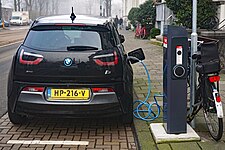| Part of a series on |
| Sustainable energy |
|---|
 |
An electric car, battery electric car, or all-electric car is an automobile that is propelled by one or more electric motors, using only energy stored in batteries. Compared to internal combustion engine (ICE) vehicles, electric cars are quieter, have no exhaust emissions, and lower emissions overall.[1] In the United States and the European Union, as of 2020, the total cost of ownership of recent electric vehicles is cheaper than that of equivalent ICE cars, due to lower fueling and maintenance costs.[2][3] Charging an electric car can be done at a variety of charging stations; these charging stations can be installed in both houses and public areas.[4]
Worldwide, 6.6 million plug-in electric cars were sold in 2021, more than doubling 2020 sales, and achieving a market share of 9% of the global new car market.[5] All-electric cars represented 71% of plug-in car sales in 2021.[6] As of December 2021, 16 million plug-in electric cars were on the world's roads.[5] Many countries have established government incentives for plug-in electric vehicles, tax credits, subsidies, and other non-monetary incentives while several countries have legislated to phase-out sales of fossil fuel cars,[7][8] to reduce air pollution and limit climate change.[9]
The Tesla Model 3 became the world's all-time best-selling electric car in early 2020,[10] and in June 2021 became the first electric car to pass 1 million global sales.[11] Together with other emerging automotive technologies such as autonomous driving, connected vehicles and shared mobility, electric cars form a future mobility vision called Autonomous, Connected, Electric and Shared (ACES) Mobility.[12]
Terminology[edit]
The term "electric car" typically refers specifically to battery electric vehicles (BEVs) or all-electric cars, a type of electric vehicle (EV) that has an onboard rechargeable battery pack that can be plugged in and charged from the electric grid, and the electricity stored on the vehicle is the only energy source that provide propulsion for the wheels. The term generally refers to highway-capable automobiles, but there are also low-speed electric vehicles with limitations in terms of weight, power and maximum speed that are allowed to travel on public roads. The latter are classified as Neighborhood Electric Vehicles (NEVs) in the United States,[13] and as electric motorised quadricycles in Europe.[14]
History
You received this message because you are subscribed to the Google Groups "1top-oldtattoo-1" group.
To unsubscribe from this group and stop receiving emails from it, send an email to 1top-oldtattoo-1+unsubscribe@googlegroups.com.
To view this discussion on the web visit https://groups.google.com/d/msgid/1top-oldtattoo-1/CAMm_%2ByaWAwpQ0-Kh_UHcuAA1e7AjNvjciG0d79gOvKFrbwzbiw%40mail.gmail.com.






No comments:
Post a Comment